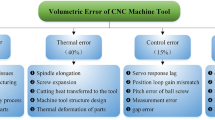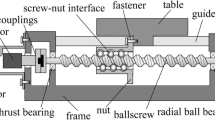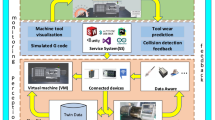Abstract
An efficient machining is limited by the chatter of machining system including spindle and support, which would cause poor surface quality. This paper proposed an improved stability prediction method based on the dynamics of machine tool. Dynamics of the support are considered into the stability prediction of machining process. The spindle was modeled by the receptance coupling substructure analysis method to predict the dynamics at the tool point. The mathematical model of the closed manufacturing system (machine tool, spindle, holder, and tool) was given, as well as the details of joint contacts. The model was used to obtain the system characteristics, and the FRFs of the tool point were obtained from the model in frequency domain. Moreover, the stability limitation for machining system were developed to create the stability lobe diagram with the FRFs of both the spindle and support. Experimental results showed that the depths of improved stability lobes were smaller than those of the original ones, and the improved lobes were more accurate for the stability predictions. The machined surface quality showed that the stable machining system was beneficial to produce good surface. This improved method is helpful for the stability calculation and machining parameter selection especially when milling a thin-walled workpiece or a weak clamping fixture.
Similar content being viewed by others
References
Albrecht P (1960) New developments in the theory of the metal-cutting process: part I. The ploughing process in metal cutting. J Eng Ind 82(4):348–357. doi:10.1115/1.3664242
Altintas Y, Ko JH (2006) Chatter stability of plunge milling. CIRP Ann-Manuf Techn 55(1):361–364. doi:10.1016/S0007-8506(07)60435-1
Nakayama K, Tamura K (1968) Size effect in metal-cutting force. J Eng Ind 90(1):119–126
Altintaş Y, Budak E (1995) Analytical prediction of stability lobes in milling. CIRP Ann-Manuf Techn 44(1):357–362. doi:10.1016/S0007-8506(07)62342-7
Altintas Y (2001) Analytical prediction of three dimensional chatter stability in milling. JSME Int J C-Mech Sy 44(3):717–723. doi:10.1299/jsmec.44.717
Montgomery D, Altintas Y (1991) Mechanism of cutting force and surface generation in dynamic milling. J Eng Ind 113(2):160–168. doi:10.1115/1.2899673
Budak E, Altintas Y, Armarego EJ (1996) Prediction of milling force coefficients from orthogonal cutting data. J Manuf Sci E-T ASME 118(2):216–224. doi:10.1115/1.2831014
Lee P, Altintas Y (1996) Prediction of ball-end milling forces from orthogonal cutting data. Int J Mach Tool Manu 36(9):1059–1072. doi:10.1016/0890-6955(95)00081-X
Altintas Y, Eynian M, Onozuka H (2008) Identification of dynamic cutting force coefficients and chatter stability with process damping. CIRP Ann-Manuf Techn 57(1):371–374. doi:10.1016/j.cirp.2008.03.048
Altintas Y, Stepan G, Merdol D, Dombovari Z (2008) Chatter stability of milling in frequency and discrete time domain. CIRP J Maunf Sci Technol 1(1):35–44. doi:10.1016/j.cirpj.2008.06.003
Krüger M, Denkena B (2013) Model-based identification of tool runout in end milling and estimation of surface roughness from measured cutting forces. Int J Adv Manuf Technol 65(5–8):1067–1080. doi:10.1007/s00170-012-4240-y
Sutherland JW, DeVor RE (1986) An improved method for cutting force and surface error prediction in flexible end milling systems. J Eng Ind 108(4):269–279
Abele E, Altintas Y, Brecher C (2010) Machine tool spindle units. CIRP Ann-Manuf Techn 59(2):781–802. doi:10.1016/j.cirp.2010.05.002
Kumar UV, Schmitz TL (2012) Spindle dynamics identification for receptance coupling substructure analysis. Precis Eng 36(3):435–443. doi:10.1016/j.precisioneng.2012.01.007
Zheng Y, Hou Z, Rong Y (2008) The study of fixture stiffness—part II: contact stiffness identification between fixture components. Int J Adv Manuf Technol 38(1–2):19–31. doi:10.1007/s00170-007-1077-x
Movahhedy MR, Gerami JM (2006) Prediction of spindle dynamics in milling by sub-structure coupling. Int J Mach Tool Manu 46(3–4):243–251. doi:10.1016/j.ijmachtools.2005.05.026
Ertürk A, Özgüven HN, Budak E (2006) Analytical modeling of spindle–tool dynamics on machine tools using Timoshenko beam model and receptance coupling for the prediction of tool point FRF. Int J Mach Tool Manu 46(15):1901–1912. doi:10.1016/j.ijmachtools.2006.01.032
Schmitz TL, Duncan GS (2005) Three-component receptance coupling substructure analysis for tool point dynamics prediction. J Manuf Sci E-T ASME 127(4):781–790. doi:10.1115/1.2039102
Schmitz TL, Davies MA, Kennedy MD (2001) Tool point frequency response prediction for high-speed machining by RCSA. J Manuf Sci E-T ASME 123(4):700–707. doi:10.1115/1.1392994
Filiz S, Cheng CH, Powellb KB, Schmitz TL, Ozdoganlar OB (2009) An improved tool–holder model for RCSA tool-point frequency response prediction. Precis Eng 33(1):26–36. doi:10.1016/j.precisioneng.2008.03.003
Ahmadian H, Nourmohammadi M (2010) Tool point dynamics prediction by a three-component model utilizing distributed joint interfaces. Int J Mach Tool Manu 50(11):998–1005. doi:10.1016/j.ijmachtools.2010.07.003
Agapiou JS (2008) Estimating the static stiffness for a spindle-toolholder-tooling system. Mach Sci Technol 12(1):77–99. doi:10.1080/10910340801890938
Ghanati MF, Madoliat R (2012) New continuous dynamic coupling for three component modeling of tool–holder–spindle structure of machine tools with modified effected tool damping. J Manuf Sci E-T ASME 134(2):21015. doi:10.1115/1.4006094
Xu C, Zhang J, Wu Z, Yu D, Feng P (2013) Dynamic modeling and parameters identification of a spindle–holder taper joint. Int J Adv Manuf Technol 67(5–8):1517–1525. doi:10.1007/s00170-012-4586-1
Siebenaler SP, Melkote SN (2006) Prediction of workpiece deformation in a fixture system using the finite element method. Int J Mach Tool Manu 46(1):51–58. doi:10.1016/j.ijmachtools.2005.04.007
Gutowski P, Berczyński S (2006) Identification of the dynamic models of machine tool supporting systems. Part II: an example of application of the method. J Vib Control 12(3):279–295. doi:10.1177/1077546306062774
Budak E (1994) Mechanics and dynamics of milling thin walled structures. University of British Columbia
Xu C, Zhang J, Feng P, Yu D, Wu Z (2014) Characteristics of stiffness and contact stress distribution of a spindle–holder taper joint under clamping and centrifugal forces. Int J Mach Tool Manu 82-83:21–28. doi:10.1016/j.ijmachtools.2014.03.006
Quinn DD (2012) Modal analysis of jointed structures. J Sound Vib 331(1):81–93. doi:10.1016/j.jsv.2011.08.017
Ahmadian H, Jalali H (2007) Identification of bolted lap joints parameters in assembled structures. Mech Syst Signal Pr 21(2):1041–1050. doi:10.1016/j.ymssp.2005.08.015
Xu C, Zhang J, Yu D, Wu Z, Feng P (2015) Dynamics prediction of spindle system using joint models of spindle tool holder and bearings. Proc Inst Mech Eng C J Mech Eng Sci 229(17):3084–3095. doi:10.1177/0954406215569588
Gao X, Li B, Hong J, Guo J (2016) Stiffness modeling of machine tools based on machining space analysis. Int J Adv Manuf Technol 86(5):2093–2106. doi:10.1007/s00170-015-8336-z
Kolar P, Sulitka M, Janota M (2011) Simulation of dynamic properties of a spindle and tool system coupled with a machine tool frame. Int J Adv Manuf Technol 54(1–4):11–20. doi:10.1007/s00170-010-2917-7
Altintas Y (2012) Manufacturing automation: metal cutting mechanics, machine tool vibrations, and CNC design. Cambridge University Press
Özşahin O, Özgüven HN, Budak E (2010) Analysis and compensation of mass loading effect of accelerometers on tool point FRF measurements for chatter stability predictions. Int J Mach Tool Manu 50(6):585–589. doi:10.1016/j.ijmachtools.2010.02.002
Graham E, Mehrpouya M, Nagamune R, Park SS (2014) Robust prediction of chatter stability in micro milling comparing edge theorem and LMI. CIRP J Manuf Sci Technol 7(1):29–39. doi:10.1016/j.cirpj.2013.09.002
Faassen R (2007) Chatter prediction and control for high-speed milling. Eindhoven University of Technology, Eindhoven
Salahshoor M, Ahmadian H (2009) Continuous model for analytical prediction of chatter in milling. Int J Mach Tool Manu 49(14):1136–1143. doi:10.1016/j.ijmachtools.2009.07.016
Schmitz TL, Davies MA, Medicus K, Snyder J (2001) Improving high-speed machining material removal rates by rapid dynamic analysis. CIRP Ann-Manuf Techn 50(1):263–268. doi:10.1016/S0007-8506(07)62119-2
Bobbili R, Madhu V, Gogia AK (2013) Effect of wire-EDM machining parameters on surface roughness and material removal rate of high strength armor steel. Mater Manuf Process 28(4):364–368. doi:10.1080/10426914.2012.736661
Albertelli P, Cau N, Bianchi G, Monno M (2012) The effects of dynamic interaction between machine tool subsystems on cutting process stability. Int J Adv Manuf Technol 58(9–12):923–932. doi:10.1007/s00170-011-3465-5
Yue J (2006) Creating a stability lobe diagram. Proceedings of the 2006 IJME-INTERTECH Conference
Mane I, Gagnol V, Bouzgarrou BC, Ray P (2008) Stability-based spindle speed control during flexible workpiece high-speed milling. Int J Mach Tool Manu 48(2):184–194. doi:10.1016/j.ijmachtools.2007.08.018
Solis E, Peres CR, Jimenez JE, Alique JR, Monje JC (2004) A new analytical–experimental method for the identification of stability lobes in high-speed milling. Int J Mach Tool Manu 44(15):1591–1597. doi:10.1016/j.ijmachtools.2004.06.011
Devillez A, Dudzinski D (2007) Tool vibration detection with eddy current sensors in machining process and computation of stability lobes using fuzzy classifiers. Mech Syst Signal Pr 21(1):441–456. doi:10.1016/j.ymssp.2005.11.007
Dos Santos RG, Coelho RT (2014) A contribution to improve the accuracy of chatter prediction in machine tools using the stability lobe diagram. J Manuf Sci E-T ASME 136(2):21005. doi:10.1115/1.4025514
Faassen RP, Oosterling JA, Van De Wouw N, Nijmeijer H (2007) An improved tool path model including periodic delay for chatter prediction in milling. J Comput Nonlin Dyn 2(2):167–179. doi:10.1115/1.2447465
Minis I, Yanushevsky R (1993) A new theoretical approach for the prediction of machine tool chatter in milling. J Eng Ind 115(1):1–8. doi:10.1115/1.2901633
Albertelli P, Goletti M, Monno M (2013) A new receptance coupling substructure analysis methodology to improve chatter free cutting conditions prediction. Int J Mach Tool Manu 72:16–24. doi:10.1016/j.ijmachtools.2013.05.003
Altintas Y, Weck M (2004) Chatter stability of metal cutting and grinding. CIRP Ann-Manuf Techn 53(2):619–642. doi:10.1016/S0007-8506(07)60032-8
Author information
Authors and Affiliations
Corresponding author
Additional information
Highlights:
A milling stability prediction method was proposed using dynamics of coupled machining system.
Modified stability lobe diagram was verified to be a better match than before from results.
The modified method is helpful when a thin-walled workpiece or weak clamping fixture using.
Rights and permissions
About this article
Cite this article
Xu, C., Feng, P., Zhang, J. et al. Milling stability prediction for flexible workpiece using dynamics of coupled machining system. Int J Adv Manuf Technol 90, 3217–3227 (2017). https://doi.org/10.1007/s00170-016-9599-8
Received:
Accepted:
Published:
Issue Date:
DOI: https://doi.org/10.1007/s00170-016-9599-8




